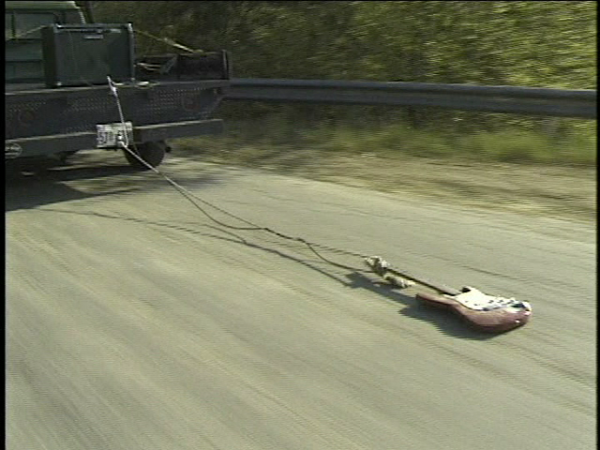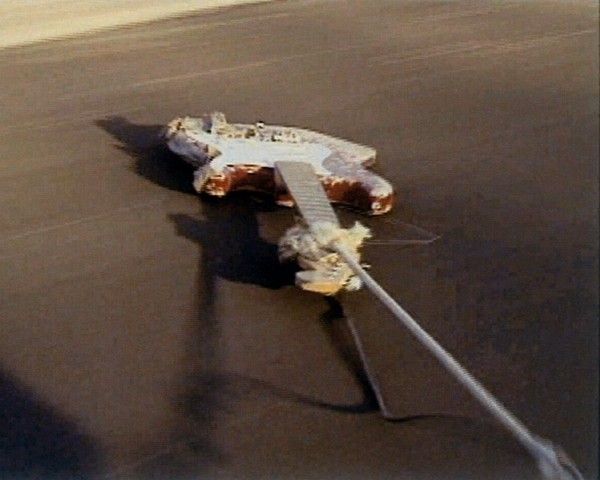By now many of you have probably read that Artpace in San Antonio is screening, for the first time, a politically loaded video by Christian Marclay that he shot in Texas sixteen years ago. A preface: a young Marclay was a resident at Artpace in 1999. At that point he came in from New York City, about one year after James Byrd Jr., a 49 year-old black man, was dragged to death behind a pickup truck in Jasper, Texas by three white supremacists. Back then, Clinton was in the White House, cell phones only made phone calls, social media was in its infancy, and the appalling crime was major world news. Perhaps the whole idea of Texas unsettled Marclay.
As far as I know, there is no photograph or video of Byrd’s murder, and my sense after watching Guitar Drag is that Marclay (not an artist known for warm or gushy work), made the work in November 1999 in an attempt to bear witness to Byrd’s death. There’s no use in talking about whether the video is “successful” or not under some kind of formal criteria, but rather: does it take you where Marclay is asking you to go, with him, to that country road in Jasper, to the truck, to the endless stretch of asphalt, to the scene of the crime? It does. It’s excruciating, graphic, and exhausting.
Even if Marclay originally aspired to multi-layered meaning in the work, Guitar Drag’s direct extended metaphor of a very real murder pulls the viewer, with immediacy, into an endurance test: by watching the video beginning to end, we’re forced to consider (at length) the unthinkable. In this way, the video surrenders its status as an art form and serves instead as a testament. Put simply, Marclay reconstructs the last thirteen minutes of Byrd’s life by dragging a screeching Fender Stratocaster behind a truck, in the place of the dying man, and filming it. The video is a nightmare. It will ruin your day, and you can count yourself lucky that that’s the worst it can do.
The video is chronological and shot in real time: Marclay has an old Trace Elliot amplifier strapped into the bed of the truck; he takes his time knotting a rope around the guitar’s neck (the rednecks used chains on Byrd), plugs it in to the amp, and duct tapes the cord onto the guitar. He lays the guitar on the dirt ten feet behind the trailer hitch, climbs into the truck and starts driving. There are several cameras in play (some mounted on the truck, some cameras are with unseen drivers in cars that follow and drive alongside the truck; the edit features multiple points of view). The guitar starts screaming immediately—a wailing feedback that sounds part human, part cat, and part horror-movie score. It’s loud and relentless. The sound alone is half the piece, maybe more.
Then there’s the drive itself. As you watch the video you can only think of Byrd’s terror and anguish. It is absolutely staggering that three men willfully drove that truck for thirteen minutes dragging a person behind it, for two miles, until his decapitation when he bounced through a trench. The solid-body guitar withstands more abuse in the beginning than any flesh and blood could, but this illustrated reimagining makes it crystal clear just how devastating being dragged to death would be; how quickly the skin breaks open and gives way to raw bone, the skull cracks, the limbs disintegrate: this is a flaying, lynching, scalping, burning, and drawn-and-quartering death, all in one. By minute two you and the guitar are done… but the drive goes on and on, and gets worse: the truck transitions from winding over weeds and gravel to a two-lane blacktop, where it speeds up (a lot) and the guitar bounces and fishtails convulsively, on and on. A helpless despair sets in.
Guitar Drag wasn’t screened at Artpace when Marclay was a resident; he shot it near the end of his session and still had to edit it. (If you want to read something about how meticulous he is about editing, here’s an excellent piece about the making of “The Clock.”) And I wonder what role the political time played in the delay. Since Obama was elected president and Trayvon Martin was murdered, it seems we’ve entered a new era of civil rights battles, with a fresh piece of bad news every week and right-wing pundits dog-whistling themselves into a froth. In this sense, the screening of Guitar Drag feels well-timed. Sixteen years on, hate crimes of great magnitude are far from over, and we should bear witness.
“Guitar Drag” is screening at ArtPace through Aug. 30.





1 comment
Pointed out to me by the conceptual artist in the house: “Guitar Drag” undoubtedly referenced Nam June Paik’s earlier works dragging a violin in the street:
http://www.floraberlin.de/soundbag/index41.html
…and particularly his “Guadalcanal Requiem” from 1977 (scroll down):
http://www.koreaherald.com/view.php?ud=20130222000469